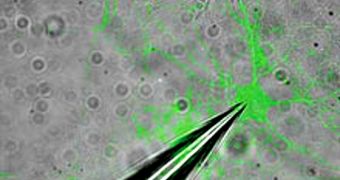Scientists have recently become aware of the ability that light has to control certain neurons. The merging research field of optogenetic neuromodulation is aimed at providing research groups around the world with the necessary background for developing devices that could use this principle. The large biotechnology manufacturer Medtronic is currently developing a prototype implant based on this idea, which could be used to control various nerve cells in the brain of patients suffering from a wide range of conditions. The new implants could render existing ones obsolete, Technology Review reports.
At this point, Deep Brain Stimulation (DBS) technology is employed in a variety of “brain pacers”. These are devices that rely on an electrode implanted in a specific region of the brain, through the skull, to deliver small electrical impulses to that area. The US Food and Drug Administration (FDA) has already allowed for this method to be used on people suffering from essential tremor (since 1997), Parkinson's disease (since 2002), and dystonia (since 2003). More than 75,000 people have had DBS-based devices implanted in their brain ever since, official statistics show.
While experts themselves know very little about how DBS works, they have proven that this type of simulation is effective at counteracting the abnormal neural activity that a host of brain disorders produce. But this therapy is not without risk. Patients complain about side-effects, such as dizziness and tingling, and experts were able to determine that these conditions occur because the electrode stimulates all neurons at the location where it is implanted. Using light is a lot more elegant and effective than this, primarily because the method can be directed only at the nerve cells that require regulation, scientists say.
In this approach, experts endow a particular subset of neurons with a gene expressing for a light-sensitive molecule called channelrhodopsin 2 (ChR2). When blue light falls on these cells, they begin firing electrical impulses, thus becoming active. However, the other neural subsets are not affected, in spite of their proximity to the light source. But the main advantage is that the neural activity that is initiated when blue light is turned on can also be stopped by shutting down the light source. “That's the other unique thing about this approach. It allows us to silence neurons' activity, which is extraordinarily difficult with electrostimulation,” says Medtronic Neuromodulation Division Senior IC Engineering Manager, Tim Denison.

 14 DAY TRIAL //
14 DAY TRIAL //